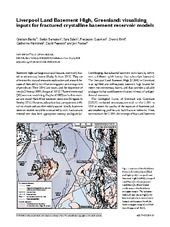| dc.contributor.author | Banks, Graham | |
| dc.contributor.author | Bernstein, Stefan | |
| dc.contributor.author | Salehi, Sara | |
| dc.contributor.author | Guarnieri, Pierpaolo | |
| dc.contributor.author | Bird, Dennis | |
| dc.contributor.author | Hamblett, Catherine | |
| dc.contributor.author | Peacock, David | |
| dc.contributor.author | Foster, Jonathan | |
| dc.date.accessioned | 2020-04-28T10:35:34Z | |
| dc.date.available | 2020-04-28T10:35:34Z | |
| dc.date.issued | 2019-07-22 | |
| dc.Published | Banks, Bernstein, Salehi, Guarnieri P, Bird, Hamblett, Peacock D, Foster J. Liverpool land basement high, Greenland: Visualising inputs for fractured crystalline basement reservoir models. Geological Survey of Denmark and Greenland Bulletin. 2019;43:e2019430204 | eng |
| dc.identifier.issn | 1811-4598 | en_US |
| dc.identifier.issn | 1604-8156 | en_US |
| dc.identifier.uri | https://hdl.handle.net/1956/22039 | |
| dc.description.abstract | Basement highs are large structural features, commonly buried in sedimentary basins (Busby & Azor 2012). They are of interest for natural resources exploration and research because of their ability to influence migration and entrapment of petroleum (Trice 2014) and water, and the deposition of metals (Hitzman 2005; Borg et al. 2012). Three-dimensional (3D) reservoir models (e.g. Shepherd 2009) are built to evaluate and model fluid-filled basement reservoirs (Ringrose & Bentley 2015). However, subsurface data are expensive, difficult to obtain and are often widely spaced. Ideally, basement reservoir models would be constrained by rock, fracture and mineral vein data from appropriate outcrop analogues (acknowledging that subaerial basement rocks have, by definition, a different uplift history than subsurface basement). The Liverpool Land Basement High (LLBH) in Greenland is an uplifted and well-exposed basement high located between two sedimentary basins, and thus provides a valuable analogue for fractured basement-hosted mineral, oil and geothermal reservoirs. The Geological Survey of Denmark and Greenland (GEUS) conducted reconnaissance work on the LLBH in 2018 to assess the quality of the exposure of basement palaeo-weathering profiles and fault-fracture networks. Here, we introduce the LLBH, the concept of fractured basement reservoir modelling, and how studying the LLBH can help enhance reservoir modelling of fractured basement. We present some of our preliminary observations of LLBH fault-fracture networks and discuss how the exposed sediment-basement features and processes might aid industry and research in their top basement mapping activities. We propose that LLBH provides a particularly suitable analogue for industry and research to analyse: (a) multiscale fracture system connectivity, (b) fluid migration and fluid-rock reaction processes, (c) input parameters for basement reservoir modelling and (d) top basement geomorphologies and processes. | en_US |
| dc.language.iso | eng | eng |
| dc.publisher | GEUS | en_US |
| dc.rights | Attribution CC BY | eng |
| dc.rights.uri | https://creativecommons.org/licenses/by/4.0 | eng |
| dc.title | Liverpool Land Basement High, Greenland: Visualising inputs for fractured crystalline basement reservoir models | en_US |
| dc.type | Peer reviewed | |
| dc.type | Journal article | |
| dc.date.updated | 2020-02-16T17:31:55Z | |
| dc.description.version | publishedVersion | en_US |
| dc.rights.holder | Copyright the authors | en_US |
| dc.identifier.doi | https://doi.org/10.34194/geusb-201943-02-04 | |
| dc.identifier.cristin | 1752813 | |
| dc.source.journal | Geological Survey of Denmark and Greenland Bulletin | |

